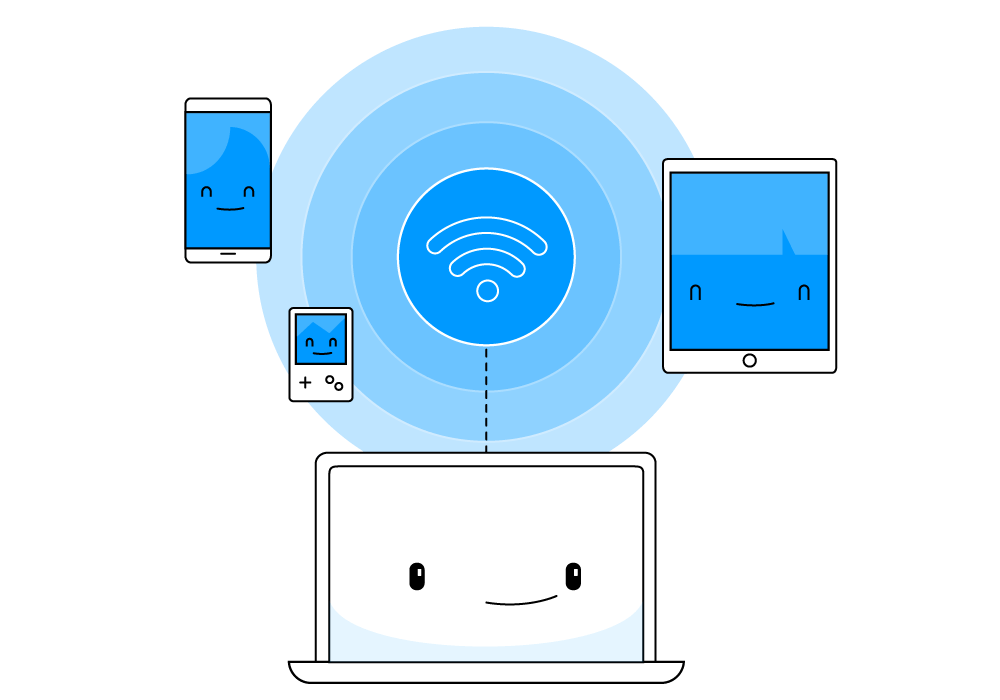
Understanding of Wi-fi bands
To choose the right channel bandwidth a person should have knowledge of the wi-fi band, only then you can analyze how much channel bandwidth is available and how you can effectively use it without any interference (distortion).
2.4GHz and 5 GHz bands are available for wi-fi.
2.4 GHz Wi-Fi band: In the 2.4 GHz band, the available bandwidth is 100 MHz, range of 2.4-2.5 GHz (2400-2500MHz). So, the total available bandwidth is 100 MHz, so channel width is also allocated accordingly so that there is no overlapping between channels. Like if we allocate 20 MHz channels, then we can allocate 4 channels only if we make more than 4 then there will be overlapping between the channel and at the time of transmission interference will take place.
5 GHz Wi-fi band: The 5 GHz band covers a range of 5725-5875 MHz, so we have a total bandwidth of 150 MHz. Unlicensed National Information Infrastructure (UNII) widens this 150 MHz band up to 750 MHz. So, as in 5GHz band, we have more channel bandwidth, here we can allocate more channels, this way you can understand the number of channels mainly depends on available bandwidth. Here, we have a total bandwidth of 750 MHz, so we can allocate more channels.
2.4GHz and 5GHz: Which is to use?
If you want long-distance coverage and high-speed connection, both things at the same time then you should use both 2.4 and 5GHz bands.
5GHz is faster: The 5GHz band provides high upload and download speed to the 2.4 GHz band. Also, here you can create more channels without any overlapping. For high-speed gaming applications and high-quality video streaming videos 5GHz band is a good choice. However, it doesn’t provide reachability across the walls.
2.4 GHz provides high reachability: The 2.4 GHz band frequencies are good at passing through solid objects. In simple words, it covers more distance than 5 GHz wi-fi band.
You can use both: By using dual band routers, you can implement 2.4 GHz and 5 GHz both at the same time. Dual band routers allow some devices to use 2.4 GHz and some devices to use 5GHz band.
What is wi-fi channel width?
Channel width is the difference between lower frequency and higher frequency. Here lower frequency means the starting frequency of the channel and higher frequency means the last frequency of that channel.
20 MHz and 40 MHz: what is the difference?
1.The main difference between 20 MHz and 40 MHz is the channel width difference. 20 MHz and 40 MHz both are representing the channel width, 20 MHz means the channel is 20 MHz wide and 40 MHz means the channel is 40 MHz wide.
2. 40 MHz channel has higher throughput than the 20 MHz channel.
3. All wi-fi clients support 20 MHz channel bandwidth so there is no compatibility issue. While other channels (40 MHz, 80 MHz), all devices don’t support these channels, so there may be a compatibility issue.
4. 20 MHz channel referred to as the narrow channel or narrow bandwidth channel while 40 MHz and 80 MHz have come under wideband channels.
What is dual band wi-fi router?
Nowadays, dual-band routers are very common, these routers support both 2.4 and 5 GHz wi-fi bands. So, this way by using a dual-band router, you can take advantage of both bands. 5 GHz band will provide you low interference and high internet speed while the 2.4 GHz band will provide you more reachability.
When to use 20 MHz, 40MHz and 80 MHz
We have discussed all the things that you should know to make a decision, which channel bandwidth we should use, now come back to our main point and let’s understand when to use which channel?
2.4 GHz Wi-Fi: For 2.4 GHz 20 MHz channel width is the right choice. As in this band, we have only 100 MHz bandwidth, if we go for 40 MHz or 80 MHz then number of channels is 2 or 1 respectively. While by using 20 MHz channel width, we can make 4 channels without overlapping.
5 GHz Wi-Fi: For 5 GHz, 40 MHz channel width is the right choice. There are other conditions too in which you can use 20 MHz, 80 MHz.
5 GHz Wi-fi: when to use 20 MHz: Channel width choice is mainly dependent on application. When there is a requirement for more channels then we use a 20MHz channel. High-density populated area and where interference is the main concern 20 MHz is the right choice.
5 GHz Wi-Fi: when to use 40 MHz: When we require minimize interference and more throughput in that case we use 40 MHz because 40MHz provides more throughput than 20 Mhz.
5 GHz Wi-Fi: when to use 80 MHz: we use 80 Mhz, when interference is not a big issue, or wi-fi client is close to router but we need more throughput.
How to automate Wi-Fi channel and width selection
Channel width choice is mainly dependent on the application. When there is a requirement for more channels then we use a 20MHz channel. High-density populated area and where interference is the main concern 20 MHz is the right choice.
Wrapping Up:
This way you can understand throughput and interference are two important parameters on the basis that channel width is selected. In short, when we need more throughput, we go for higher channel bandwidth (40 or 80 MHz) and when interference is the main concern and we need more channels in that case we use smaller channel width (20 MHz). There are some secondary parameters too- number of channels, speed and more distance coverage.


